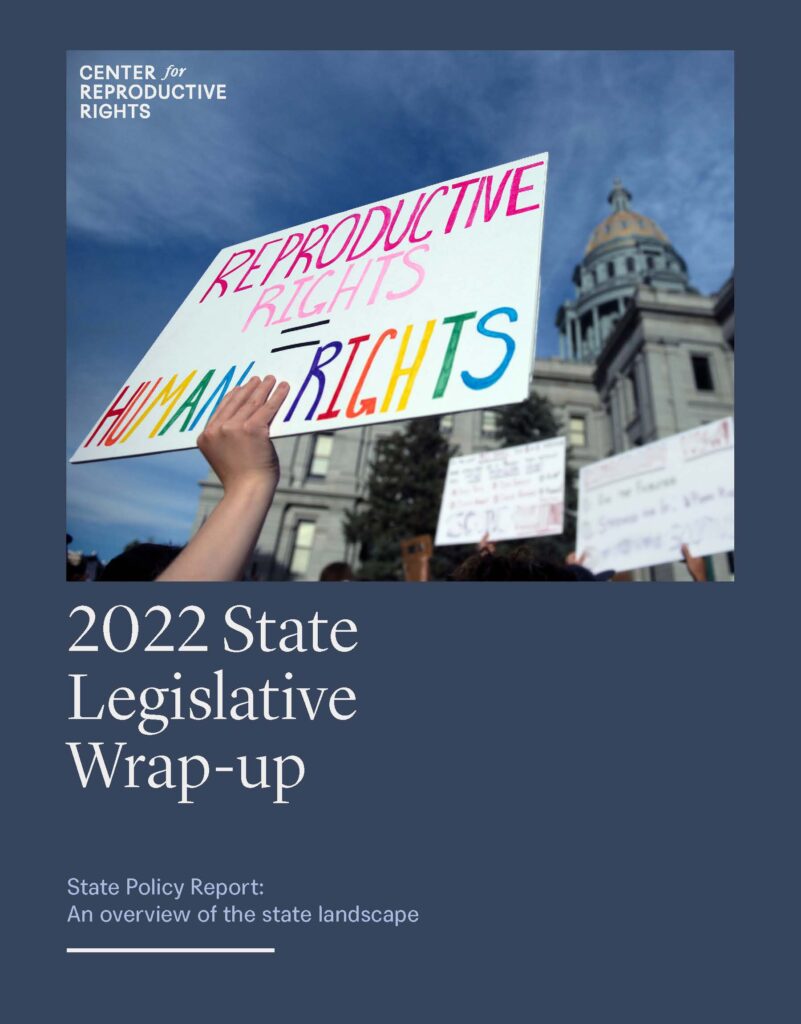
2022 State Legislative Wrap-up
This Center report provides an overview of the state policy landscape after analyzing hundreds of bills proposed and enacted in U.S. state legislatures relating to reproductive care.
Introduction
In 2022, lawmakers in states hostile to reproductive rights intensified their efforts to attack legal protections for abortion, failing to pass laws to safeguard maternal health and declining to expand access to fertility care. In contrast, lawmakers in states supportive of reproductive rights took steps to protect abortion rights and improve access to maternal and fertility care.
These findings come from a new report published by the Center for Reproductive Rights, the 2022 State Legislative Wrap-up. The report provides an overview of the state policy landscape after analyzing hundreds of bills proposed and enacted in U.S. state legislatures relating to reproductive care.
In addition to tracking bills on abortion, this year’s report includes maternal health care and assisted reproduction.
“We hope this report provides a thorough understanding of what’s really happening in state legislatures as the fight for reproductive autonomy will continue to be focused on the states,” said Elisabeth Smith, the Center’s director, state policy & advocacy.
“The differences in lawmakers’ priorities and approaches during the year were incredible, with some states rushing to ban abortion and others strengthening efforts to defend abortion rights and access.”
Elisabeth Smith, director, state policy & advocacy
I. Abortion Rights
In June, the U.S. Supreme Court eliminated the federal constitutional right to abortion, clearing the states to ban abortion entirely. During the year, multiple states rushed to enact abortion bans and restrictions that will only worsen reproductive health outcomes instead of addressing increasing maternal mortality, which disproportionately impacts Black women and birthing people.
In contrast, legislators in states where abortion remains legal enacted new policies to protect providers, helpers, and patient medical records and earmarked funding to support people traveling from states where abortion is criminalized.

During the year, almost 700 bills were proposed relating to abortion: 430 bills restricted or banned abortion, and 230 protected abortion rights and access. Bills were both in anticipation of, and as a result of, the Supreme Court’s ruling overturning Roe v. Wade.
Read more about abortion rights bills here.
430
Bills proposed to restrict or ban abortion.
12
States where abortion is now illegal.
230
Bills proposed to protect abortion rights and access.
Restrictive Bills
By year-end 2022, abortion had become illegal in 12 states: Alabama, Arkansas, Idaho, Kentucky, Louisiana, Mississippi, Missouri, Oklahoma, South Dakota, Tennessee, Texas, and West Virginia. Over 20% of the U.S. population resides in those states, leaving millions without access to abortion care.
Legislators opposed to abortion focused on pre-viability abortion bans, medication abortion restrictions, and funding for crisis pregnancy centers, with 21 states enacting 36 bills of the 430 introduced.
-
Many states moved to ban abortion outright through trigger bans and gestational bans. Of 12 trigger bans proposed, three were enacted or amended and of 100 gestational bans proposed, nine were enacted.
-
Medication abortion was a particular target during 2022, as many view it as the next frontier in the war against abortion access. After 28 states introduced 50 medication abortion restrictions, five laws were enacted, including one total ban.
-
Seven laws banning the use of telemedicine for abortion were enacted.
-
Eight states passed laws to fund crisis pregnancy centers, which use deceptive practices to divert people away from receiving abortions.
Read more about restrictive bills here.
Proactive Bills
Numerous states acted to protect abortion rights and access, with bills focused on protecting abortion providers and individuals seeking care outside of their home states. Legislators also worked to expand insurance coverage and the types of clinicians allowed to provide abortion care.
-
Of the 230 proactive bills proposed, 42 were enacted in 13 states.
-
Interstate shield laws—which shield “access state” providers, patients, and people assisting in abortion provision—were introduced in 10 states and enacted in six.
-
Seven laws were enacted to expand scope of practice to certified nurse midwives, nurse practitioners, and other qualified medical professionals.
-
Five laws were enacted to expand private insurance coverage and 14 to expand state funding for abortion care.
-
Two states enacted laws to make abortion a fundamental right through statute.
Read more about proactive bills here.
State Constitutional Amendments
Some state legislatures sought to amend their state constitutions to expand reproductive freedom or limit abortion access by referring initiatives to ballot votes.
-
Of five bills proposed in four states to protect or expand access, two were enacted (California and Vermont), and both were approved by voters in November.
-
Twelve bills proposed amendments to limit abortion access, with one passing (Pennsylvania) that is subject to additional legislative action.
Read more about state constitutional amendments here.
II. Maternal Health
Despite declines in maternal mortality globally, people in the U.S. continue to experience high rates of maternal mortality and severe maternal morbidity. While during the year lawmakers introduced more than 800 bills related to maternal health care and enacted 145 in 35 states and the District of Columbia, legislative accomplishments to protect pregnant people were modest.

“Although there was political interest in maternal health, the 2022 legislative accomplishments were modest and the need to better protect pregnant people’s rights remains great.”
800
Bills related to maternal health care proposed.
145
Maternal health-related laws enacted.
8
States enacted postpartum Medicaid extension (PPME) laws.
-
Extending Medicaid coverage to a full year postpartum can alleviate maternal mortality and morbidity. Laws enacted to improve funding for maternal health care services included eight postpartum Medicaid extension (PPME) laws, two laws allowing for Medicaid coverage of doula services, and five laws relating to postpartum mental health care.
-
Several states proposed bills for paid parental leave, as there is no federal requirement that parental leave be paid. Three states created universal paid parental leave and three others passed laws to create a form of paid leave for state employees only.
-
Two states enacted laws relating to Maternal Mortality Review Committees (MMRC) to improve understanding of people who died during, or within a year of, pregnancy.
-
Additional maternal health bills addressed bereavement leave; provider licensure; substance use disorder screening and treatment; and treatment of people incarcerated during pregnancy, birth, or postpartum.
Read more about maternal health bills here.
III. Assisted Reproduction
Infertility impacts millions of people in the U.S., yet numerous barriers—such as limited information, restrictive laws and policies, stigma, high costs, and more—put fertility care, including in vitro fertilization (IVF), out of reach for many. During 2022, states considered more than 160 bills related to assisted reproduction and enacted 18 in 12 states and the District of Columbia.

“Without proactive legislation, access to assisted reproduction including IVF could become as state specific as abortion care access has become.”
160
Bills related to assisted reproduction proposed.
2
Laws enacted to expand access to IVF.
2
Laws enacted prohibiting research that would destroy a human embyo.
-
Major trends in assisted reproduction legislation included expanding access to IVF, regulating embryos and gametes, and legalizing and regulating surrogacy agreements.
-
While 110 bills were proposed to expand access to IVF, only two laws were enacted.
-
Massachusetts became the first state to enact an interstate shield law that explicitly included protections for assisted reproduction providers.
-
Thirty-three bills were introduced related to the regulation of embryos and gametes. Of the four that passed, two prohibited research that would destroy a human embryo.
-
Five states introduced, but did not pass, bills that would legalize and regulate compensated gestational surrogacy.
Read more about assisted reproduction bills here.
Looking Ahead
The trends of 2022 are likely to continue in 2023, according to the 2022 State Legislative Wrap-up. “Some states will introduce creative bills to restrict abortion, including via novel criminal penalties, and others will seek to protect access to abortion,” says the report. More pregnant people are expected to be denied access to care and forced to travel across multiple state lines and, for those without means to travel, to continue pregnancies against their will.
The need to better protect pregnant people’s rights and health remains great, and efforts to improve maternal health must meaningfully address accountability and equity. Considering the increased state efforts to ban abortion, threats to assisted reproduction may also follow.
“This report confirms what we already knew: that the states most aggressively banning or restricting abortion are unlikely to pass laws that promote or safeguard maternal health,” said Smith.
“The divide between states with strong reproductive health policies and states where maternal health is neglected will only continue to grow without understanding and consequential action from lawmakers.”
Read more.
-
After Roe Fell: Abortion Laws by State—Get real-time analysis of abortion laws and policies in all U.S. states with this interactive tool.
-
Abortion on the Ballot—In 2022, Americans across the political spectrum voted to preserve or expand reproductive rights. When abortion was directly on the ballot, abortion rights supporters won every contest.
-
The Women’s Health Protection Act (WHPA)—WHPA is federal legislation that creates a new legal protection for the right to provide and access abortion care.
-
The Center’s State Advocacy Work—The Center works in U.S. states to implement reproductive rights policy initiatives and strategies that improve access to abortion care and prevent restrictions.

